大学英语视听说教案Unit
新世纪大学英语(第二版)视听说教程2(3rd Edition)unit1电子教案(答案)

Key
Lesson A The people in my life
Listening
Lesson B Special people and memories
Activity 1 Nosy Nora B Listen again. What do you think nosy means? What might a nosy person do?
An English Video Course 2 视听说教程(3rd Edition)电子教案 2
Unit 1 All About Me
Lesson A The people in my life
Lesson B Special people and memories
Vocabulary Link
II ■
A nosy person might o_t_h_e_r_p_e_o_p_l_e’_s_a_f_fa_i_r_s .
b_e__to_o__in_t_e_r_es_t_e_d_i_n_t_h_in_g_s__th_a_t_d_o__n_o_t _c_o_n_ce_r_n__th_e_m__, _es_p_e_c_i_al_l_y
I’d tell my parents, because they ___ ______________.
Lesson A The people in my life
Listening Activity 1 Nosy Nora
Lesson B Special people and memories
Language Notes
Proper names Myles Katherine Jones Parkside Apartments
大学英语视听说教程课件 Unit 10 Love and Friendship

Unit 10
Love and Friendship
Part 1 Listening Skills
Exercise A
Word Tips
liberation / lɪbə'reɪʃən/ n. 解放 becoming free
surface /'sɜːfɪs/ n. 表面 the outer appearance of a person
Part 2 Conversation Listening
Conversation 1
C. Pair work: Watch the video clip again, repeat it sentence by sentence, and then role-play it in pairs. After the practice, change roles.
wallet /'wɒlɪt/ n. 钱包 pocketbook
envy /'envɪ/ v. 忌妒 to sions, etc.
as sb. else
top /tɒp/ v. 胜过 to be better than
Part 1 Listening Skills
B. Listen to the conversation again and supply the missing words.
新世纪大学英语视听说(第三版)3 Unit4

■
2 a. ____ The passengers ate some bad food.
4 b. ____ The passengers had severe indigestion.
c. ____ The passengers went to the hospital. 6 1 d. ____ The cruise ship departed. 5 e. ____ The cruise ship returned home. f. ____ The passengers felt lightheu know ever ______? fainted? B: Oh, yes. He was one of my high school friends. One day he justjust fell on ____ _____ he ____ onthe fell on the _____ andconsciousness. ___ floor and lost consciousness. floor and lost ____ ________. A: What happened_____? _______ then? B: We felt very anxious. So one of us hurried hurried to tell our teacher, and of ____ ____ _____. So ____ ____ ___ to tell our teacher, and the rest ___ ___ ___ ___ waited us waited beside him. beside him. A: Was it serious? __ ______? B: Thankfully,it wasn’t. He recovered before our teacher arrived. ________, it wasn’t. He _______ before our teacher arrived. recovered before our teacher arrived. A: How lucky! _____! B: Yeah, he really was. He told us that he had been playing online games all ___ _____and he hadn’t eaten anything. That’s why hehe ___ _______ and fainted. night and he hadn’t eaten anything. That’s why hefelt lightheaded and ______. night and he hadn’t eaten anything. That’s ____ felt lightheaded and fainted.
新世纪大学英语(第二版)视听说教程1(3rd Edition)unit2电子教案(答案)【精品荟萃】
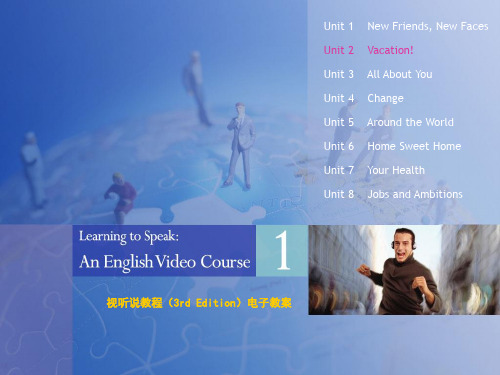
Adjectives a. sunny b. cloudy c. windy d. clear Verbs e. raining f. snowing
HOME MY PAGE AROUND THE GLOBE
TODAY’S WEATHER
Around the globe
Montreal, Canada 28oF/-2oC
1. It’s ________.
Portland, Oregon, USA 55oF/13oC
2. It’s ______.
Shanghai, China 42oF/5.5oC
3. It’s ______.
NEWS
hot sunny cold
blizzard n. 暴风雪
hurricane n. 飓风
sleet n. 雨夹雪
overcast a. 阴天
humid a. 潮湿的
foggy a. 有雾的
warm wet
dry
tornado n. drought n. hail v. freezing a. muggy a.
A: What a lovely day! B: Yes, isn’t it?
An English Video Course 1 视听说教程(3rd Edition)电子教案 1
Vocabulary Link How’s the weather? A Pair work. Look at the weather report. Match a word in the box with a city.
An English Video Course 1 视听说教程(3rd Edition)电子教案 1
新世纪大学英语视听说教程第三版第2册 unit1 电子教案ppt课件
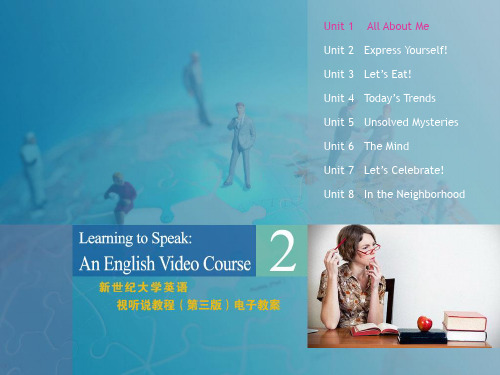
party.”
6. “We work in the same
office every day.”
3
2
6 4
1 Unit All About Me Lesson A The people in my life Lesson B Special people and memories
An English Video Course 2 视听说教程(第三版)电子教案 2
Key
1 Unit All About Me Lesson A The people in my life Lesson B Special people and memories Listening
Vocabulary Link
InTtahlkeinngeiagbhobuotrhreoloadtionships
B Pair work. Interview a partner and ask and answer this question: Who would you talk to if you … ? Choose from the situations and people below or use your own ideas.
New words van n. 小货车 nosy a. 多管闲事的,爱打听的
move in 搬进来,迁入
1 Unit All About Me Lesson A The people in my life Lesson B Special people and memories Listening
An English Video Course 2 视听说教程(第三版)电子教案 2
Activity 1 Nosy Nora
大学英语视听说unit5教案
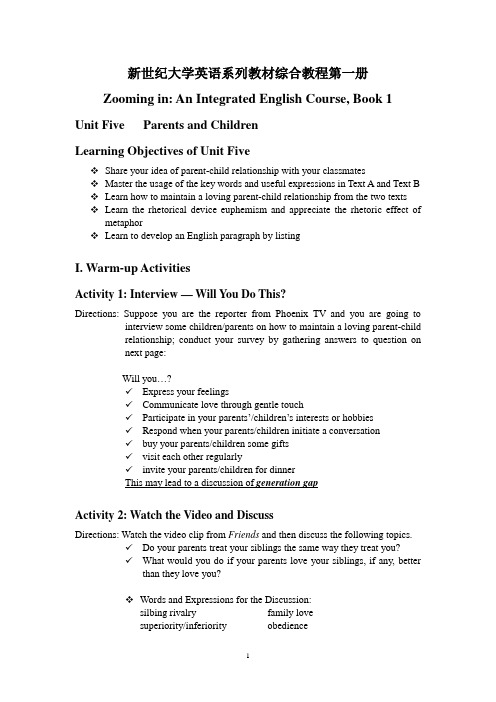
新世纪大学英语系列教材综合教程第一册Zooming in: An Integrated English Course, Book 1 Unit Five Parents and ChildrenLearning Objectives of Unit FiveShare your idea of parent-child relationship with your classmatesMaster the usage of the key words and useful expressions in Text A and Text B Learn how to maintain a loving parent-child relationship from the two texts Learn the rhetorical device euphemism and appreciate the rhetoric effect of metaphorLearn to develop an English paragraph by listingI. Warm-up ActivitiesActivity 1: Interview — Will Y ou Do This?Directions: Suppose you are the reporter from Phoenix TV and you are going to interview some children/parents on how to maintain a loving parent-childrelationship; conduct your survey by gathering answers to question onnext page:Will you…?✓Express your feelings✓Communicate love through gentle touch✓Participate in your parents’/children’s interests or hobbies✓Respond when your parents/children initiate a conversation✓buy your parents/children some gifts✓visit each other regularly✓invite your parents/children for dinnerThis may lead to a discussion of generation gapActivity 2: Watch the Video and DiscussDirections: Watch the video clip from Friends and then discuss the following topics.✓Do your parents treat your siblings the same way they treat you?✓What would you do if your parents love your siblings, if any, better than they love you?Words and Expressions for the Discussion:silbing rivalry family lovesuperiority/inferiority obediencemale heir mum’s petsexist/sexism rebellionfamily line growing painsinequality of the sexes mutual understandingprejudice/discrimination long-cherished valuesII. Text A A Time for Memories1. Background InformationPromIn the United States and Canada, a prom, short for promenade, is used to describe a formal dance held at the end of an academic year. Boys usually dress a dinner jacket and bow tie, sometimes with brightly colored cummerbunds (腰带) or vests, though any sort of formal wear can be worn. Traditionally, girls gave boys matching boutonnieres (纽扣眼上插的花) to be worn on their tuxedos or waistcoats. Girls traditionally wear formal gowns or dresses adorned with a corsage (胸前花饰) given to them by their dates. Common prom activities include dining, dancing, the crowning ofa prom King and Queen, and socializing.2. Key Words and Useful Expressions2.1 recent a. (L. 6) happening or starting from a short time ago 最近的e.g. According to a recent survey, the percentage of working women is stuck at32%.据最近一项调查显示,职业女性的比例保持在百分之三十二。
新世纪大学英语(第二版)视听说教程1(3rd Edition)unit1电子教案(答案)【精品荟萃】

An English Video Course 1 视听说教程(3rd Edition)电子教案 1
Vocabulary Link
InOtnhleinneepigehnbpoarhlsood A Look at Silvia’s website. Complete the website with the words in the box.
1 Unit New Friends, New Faces Lesson A Meeting new people Lesson B What does he look like?
An English Video Course 1 视听说教程(3rd Edition)电子教案 1
Vocabulary Link
_____________:
Message: Hi everyone! I want to make friends with people from all over the world. E-mail me and tell me about you and your country!
1 Unit New Friends, New Faces Lesson A Meeting new people Lesson B What does he look like?
Today’s new member:
___________: Silvia ___________: Carvalho ___________: 23 years old ___________: São Paulo ___________: Brazil ___________: Portuguese, English ___________: computer science
应用型大学英语视听说1-教案Unit8ChineseOpera

《应用型大学英语——视听说》教案单元名称:Unit 8 Chinese Opera单元话题:All about Chinese operaPart One: Purpose of T eachingIn this unit, we will focus on Chinese opera. We will learn relevant vocabulary and expressions. We will also learn how to ask the way in oral communication. Oral activities in different forms will be conducted to practice these language skills.Part Two: Time ArrangementPart Three: Teaching ContentsⅠLead-in (10 minutes)●Make students think about what they know about Chinese opera: what Chineseopera performances they have watched, which famous performer they like, What advantages and disadvantages they can think of concerning the development of Chinese opera on the international stage, etc.Culture Link●Lead students to read the passage about Peking Opera.Beijing Opera (Peking Opera)Beijing opera, more commonly known as Peking Opera to westerners, is deemed the national opera of China.The accompanying music, singing and costumes are all fascinating and artistic. Full of Chinese cultural elements, the opera presents to the audience an encyclopedia of Chinese culture as well as unfolding stories, beautiful paintings, exquisite costumes, graceful gestures and acrobatic fighting.Since Beijing Opera enjoys a higher reputation than other local operas, almost every province of China has more than one Beijing Opera troupe.There're also many troupes formed by non-professional performers, who are called "piaoyou" in Chinese.Beijing Opera is so popular among Chinese people, especially seniors, that even a "Beijing Opera Month" has been declared.HistoryBeijing Opera has an over 200-year history. The main melodies originated from Xipi and Erhuang, originally from Anhui and Hubei province respectively and over time techniques from many other local operas were incorporated.It is said that Beijing Opera gradually came into being after 1790 when the famous four Anhui opera troupes came to Beijing. Beijing Opera underwent fast development during the reign of Emperor Qianlong and the notorious Empress Dowager Cixi under the imperial patron, and eventually became more accessible to the common people.In the ancient times, Beijing Opera was performed mostly on open-air stages in markets, streets, teahouses or temple courtyards. The band had to play loudly and the performers had to develop a piercing style of singing, in order to be heard over the crowds.The costumes were a garish collection of sharply contrasting colors because the stages were dim and lit only by oil lamps.It is a harmonious combination of Grand Opera, Ballet and acrobatic display, consisting of dancing, dialogue, monologue, acrobatic combat and mime.The BandThe Beijing Opera band mainly consists of orchestra band and percussion band. The former frequently accompanies peaceful scenes while the latter often follows scenes of war and fighting. The commonly used percussion instruments include castanets, drums, bells and cymbals. One person usually plays the castanets and the drum simultaneously, who serves as conductor of the whole band as well.The orchestral instruments mainly compose of the Erhu, the Huqin, the Yueqin, the Sheng (reed pipe), the Pipa (lute) and other instruments. The band usually sits on the left side of the stage.The RolesThere are four main roles in Beijing Opera: Sheng, Dan, Jing and Chou."Sheng" are the leading male actors and are divided into:"Laosheng," - who wear beards and represent old men"Xiaosheng," - who represent young men"Wusheng," - who play military men and fighters"Wawasheng" - who play kidsThe above roles usually wear no facial paintings. "Hongsheng", another category of "Sheng" whose face is painted red, mainly plays "Guanyu" (ChineseAres) and "Zhao Kuangyin" (the founder of the Song Dynasty)."Dan" is the female roles. Formerly, the term meant female impersonator. It is divided into many categories"Laodan" - are the old ladies"Caidan" - the female comedians"Wudan" - usually play military or non-military women capable of martial arts"Qingyi" - the most important category, usually play respectable and decent ladies in elegant costumes"Huadan" - represent lively and clever young girls, usually in short costumes"Jing", mostly male, are the face-painted roles who represent warriors, heroes, statesmen, adventurers and demons. "Jing" is generally categorized into "Zhengjing," "Fujing" and "Wujing"."Chou" refers to clowns who are characterized by a white patch on the nose.Usually white patches of different shape and size mean different characters. They are not definitely rascals, while most of the time they play roles of wit, alert and humor. It is these characters who keep the audience laughing and improvise quips at the right moments to ease tension in some serious plays.Facial PaintingIt is said that this special art derived from the Chinese opera has different origins. But no matter what its origin is, the facial painting is worth appreciating for its artistic value. The paintings are presentations of the roles of the characters.For example, a red face usually depicts the role's bravery, uprightness and loyalty; a white face symbolizes a sinister role's treachery and guile; a green face describes surly stubbornness, impetuosity and lack of self-restraint.In addition, the pattern of the facial painting reveals the role's information too. In a word, the unique makeup in the opera allows the characters on the stage to reveal them voicelessly.W arm-up Exercises Sound RecognitionMake students read each group. Ask them to pay special attention to the sound difference in them. Then play the recording to ask them to pick out the sound they hear and check the answers.Activity 1 Listening●Direct students to read and learn the words and expressions in the word box.●Direct students to read questions first and predict what they are going to hear.●Play the recording.●Check answers and explain. Have them underline useful oral expressions ifpossible.Activity 2 Viewing●Direct students to read questions first and predict what they are going to hear.●Play the recording.●Check answers and explain.Word Bankobsess(使)牵挂,(使)着迷gong锣cymbal铜钹be obsessed with 痴迷于……Activity 3 Speaking●Teachers are expected to require the students to work in pairs, and then ask one ortwo groups to present their own discussions.●Ask students to survey to see how many students share the same opinion.ⅡCommunication Skills (20 minutes)Activity 1 Oral Functions●Go over the listed expressions one by one. If necessary, translate them intoChinese.●Lead the class to read these expressions, and pay special attention to soundlinking.Activity 2 Oral PracticeTask 1 Listening●Play the recording and check answers.●Underline important communication skill patterns.Task 2 Viewing●Familiarize students with the background of the video.●Play the video (twice if possible).●Check answers.Task 3 Speaking●Prepare several groups of words related to the possible topics that may bediscussed by students. Advise them to focus on just one topic.●Allow enough time for students to work in pairs.●Invite volunteer pairs to show their dialogue to the whole class.●Encourage students’ progress in oral practice.ⅢIn-putting & Out-putting (30 minutes)Activity 1 Listening to learn●Direct students to check words and expressions in the activity. Encourage them toname any word they think is new and briefly explain it.Task 1 Listening for information●Have students read statements first and play the recording.●Check answers.Task 2 Listening for details●Play the recording once again.●Check answers.●Make sure students have got the correct spelling.Task 3 Oral practice●Allow students to discuss in pairs or in groups.●The teacher walk around to offer any help when necessary.●Students report to the whole class about their discussion results.Word Bankpilot /ˈpaɪ.lət/ adj. 引导的,示范的primary school小学secondary school中学Ministry of Education教育部Activity 2 Viewing to learn●Make students to guess what will happen in the video.●Lead them to read and study the words in the box.Task 1 Viewing for information●Play the video●Check answers.Task 2 Viewing for details●Play the video once again●Check answers.●Solve any problems students may have.Task 3 Oral Practice●Encourage students to make the conversation colorful and interesting. Pay specialattention to the interview skills.Word Banklegacy 祖先传下来之物,遗赠物Los Angeles洛杉矶Mei Lanfang 梅兰芳Mei Baojiu 梅葆玖(梅兰芳之子)China Daily 《中国日报》ⅣFollow-up Activities (20 minutes)Activity 1 Listening to LearnTask 1 Listening for information●Lead students to read and study the words in the box.●Have students read questions first and play the recording.●Check answers.Word Bankcriticism 批评,评论reveal 显示,透露fame名声,名望Task 2 Oral Practice●Allow enough time for students to divide their groups into two.●Each group should nominate a group leader to gather facts and proofs for theirdebate.●The teacher walks around to offer any necessary help to each group.●Presentation skills are required while students hold the debate.Activity 2 Viewing for informationTask 1 Viewing for Information●Lead students to read and study the words in the box.●Make students to carefully read the statement and see if there is any clue.●Play the video and check answers.Word Bankcelebrate庆祝,庆贺,颂扬amateur业余爱好者,外行decorate 装饰,装修judge评委contestant竞争者,参赛者,提出异议者enthusiast 热心人,热衷者anniversary周年纪念(日)Task 2 Oral practice●Ask students to prepare for this part before class.●Let students limit their presentation with three-minutes.●Presentation skills are expected to introduce to students.●Evaluation is necessary after students’ presentation.V. Entertainment (5 minutes)●Some introduction to the song and the singer.●Play the recording once for students to enjoy.●Play it the second time and ask students to fill in the blanks.●Check answers.●If necessary, play it the third time.Review Checklist(5 minutes)●Have students finish the checklist in class or after school.。
大学英语视听说教案.doc
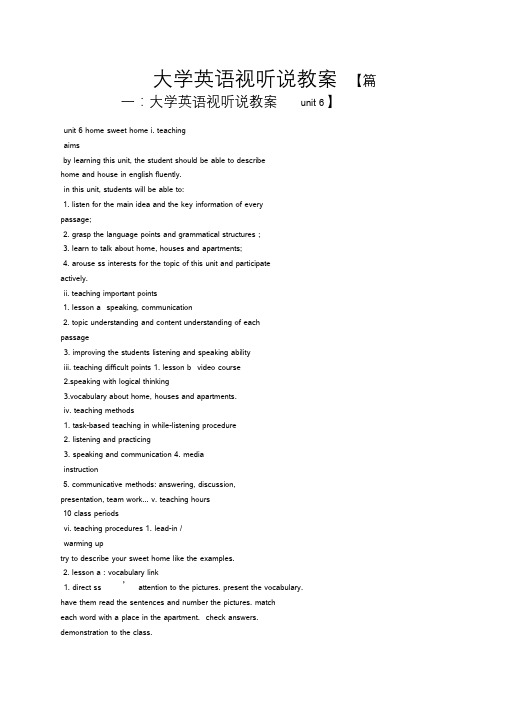
大学英语视听说教案【篇一:大学英语视听说教案unit 6 】unit 6 home sweet home i. teachingaimsby learning this unit, the student should be able to describehome and house in english fluently.in this unit, students will be able to:1. listen for the main idea and the key information of everypassage;2. grasp the language points and grammatical structures ;3. learn to talk about home, houses and apartments;4. arouse ss interests for the topic of this unit and participateactively.ii. teaching important points1. lesson a speaking, communication2. topic understanding and content understanding of eachpassage3. improving the students listening and speaking abilityiii. teaching difficult points 1. lesson b video course2.speaking with logical thinking3.vocabulary about home, houses and apartments.iv. teaching methods1. task-based teaching in while-listening procedure2. listening and practicing3. speaking and communication4. mediainstruction5. communicative methods: answering, discussion,presentation, team work... v. teaching hours10 class periodsvi. teaching procedures 1. lead-in /warming uptry to describe your sweet home like the examples.2. lesson a : vocabulary link1. direct ss ’attention to the pictures. present the vocabulary.have them read the sentences and number the pictures. matcheach word with a place in the apartment. check answers.demonstration to the class.3. lesson a : listening(1). apartment huntingfamiliarize ss with the new words. have them read the newwords aloud after you. explain the task. play the recording.check answers.tell ss to listen again and mark their answers. play therecording. check answers. introduce the topic that the mantalks about three apartments. number the apartments 1 to 3 asyou listen. have ss listen and fill in the blanks with words theyhear. play the recording. check answers. have ss read throughthe questions and possible answers. tell ss to listen again andcheck the correct boxes. play the recording. check answers.(2). a housing problemintroduce the topic :listen to graciela talk to an adviser at herschool. then answer the questions. then tell them to listen andnumber the steps in order. play the recording. check answers.tell ss to listen again and answer the questions. play therecording. check answers.(3). the davis family wants a new home.tell ss they are going to listen to the program “places for rent. ”. direct ss ’attention to the picture anadsk them to readthe questions. tell ss to listen and answer the questions. playthe recording. check answers.tell ss to listen again and fill in the blanks with the words in thebox. play the recording. check answers.(4). make yourself at home!introduce the topic. tell ss they are going to listen to apassage. tell ss to listen carefully and write short answers tothe questions. play the recording.check answers.have ss lookat the pictures carefully. tell them to listen to the recording andnumber the pictures to match them with the explanations. playthe recording. check answers.tell ss to listen again and fill in the blanks with the words theyhear. play the recording. check answers.(5). object-shaped housesdirect ss ’attention to the title. w hat will they hear? present thenew words and have ss read aloud after you. answer anyquestions about vocabulary.with the class, go over the list of questions. tell ss to listenand number the questions in the order they are asked duringthe interview. play the recording. check answers.have ss read the statements. explain that all these statementsare false. tell ss to listen again and correct the statements. playthe recording. check answers.tell ss to listen again and write answers to the questions. playthe recording. checkanswers.4. lesson a : pronunciation1. remind students rising intonation to show surprise. play therecording. have ss work in pairs to practice the conversations.2. have ss listen and read the sentences. play the recording.ask ss to work inpairs to read the sentences. check their pronunciation..5. lesson a : speaking and communicationactivity one1. introduce the situation. how many rooms are there? ask ssto listen and fill in the blanks with the words they hear. play therecording.check answers.2. put ss in groups of three. present the conversations again.ask ss to listen and read along in their groups. play therecording again. ask ss to practice the conversations ingroups. remind ss to keep eye contact with their groupmembers while speaking.3. ask ss to work in groups of three. ask ss to read the modelconversation. answer any questions about vocabulary. ifnecessary, play the recording. elicit or explain to ss who thefamous celebrities are.4. have ss work in groups of three. each student should role-play a famous person. have ss work in their groups to createand practice a new conversation where they introduce eachother. when all groups【篇二:大学英语视听说3-unit1 教案及首页】北华航天工业学院教案unit 1 interests and hobbiesi. dictationask the students to do the dictation of the words in text a unit1.ii. lead-in and video-watchingask the students to work in groups, learn to express likes ordislikes i (don ’t) like ⋯⋯is my favorite. i prefer ⋯to ⋯i care for ⋯⋯is the last thing i would do watch the video and do the exercisesiii. listening skills for short passages1. a few ways to help students conclude the main idea 1).explaining what a topic sentence isusually placed in the beginning, or at the end of a passage, orsome times appears in the middle of the passage where thekey words are frequently repeated. 2). listening for general idearead and analyze the choices first. infer the question. find therepeated words. listen to the passage and pay special attentionto the beginning or the ending part of the passage.2. skill practice: listen to the following three passages andanswer the questionsiv. comprehensive training put the skills into practice1. 5 short conversations and a long conversation2. 1 shortpassage 3. dictationv. assignment1. further listening practice in unit 12. remember the new words, phrases in the listening exercises3. finish the exercises left in unit 1 in students ’textbooks北华航天工业学院教案unit 2. life and fashioni. dictationask the students to do the dictation of the words in text a unit2.ii. lead-in and video-watchingask the students to work in groups, learn to seek advice fromothers how do you feel? what about...?how do you think about ?whats your opinion? what is your view? what do you think? watch the video and do the exercises iii. listening skillsfor short passages1. make the students familiar with different kinds of numbers2.explain how the numbers are tested.3. tips: pay attention to the digit; pay attention to the ways ofreading numbers; pay attention to the use of commas; payattention to the calculation.4. skill practice: listen to the following three passages andanswer the questionsiv. comprehensive training put the skills into practice1. 5 short conversations and a long conversation2. 1 shortpassage 3. dictationv. assignment1. further listening practice in unit 22. remember the new words, phrases in the listening exercises3. finish the exercises left in unit 2 in students ’textbooks北华航天工业学院教案【篇三:《新视野大学英语视听说教程3》课时10 教案】《新视野大学英语视听说教程3》课时10 教案(unit 1 part Ⅱ~unit 1 part Ⅳmodel 1 )授课人:成诚文章大意:墨菲和一个美国人去应聘同一个职位,由于他们学历相同, 所以主管对他们进行了一次测试,结果他们都有一个问题没有回答出来,但最终美国人却被录取,这是为什么呢?(原因:美国人在不会的题目上写的是”我不会”而墨菲写的是”我也是”.★word tips:1.dublin: 都柏林(爱尔兰首都)①(令人吃惊的)巧合,巧事2.coincidence:[ k?uinsid?ns][n] ②同时存在③(意见等的)相同,相符,一致3.bewilder:[ biwild?][v] 使迷惑,使糊涂4.indignant:[ indign?nt][adj] ~(at/about something) 愤慨的,愤怒的,义愤的★words in text:irish[ai?ri?][n] ①爱尔兰语②爱尔兰人[adj] 爱尔兰的,爱尔兰人的,爱尔兰语的文章大意:本文讲述了在应聘时常被问到的一些难题,作者通过本文教你如何去应对这些问题.★word tip:customize:[ k?st?maiz][v]( 以满足顾客的需要)订制,订做,改制★words in text:1.relevant:[ reliv?nt][adj] ①紧密相关的,切题的②有价值的,有意义的①(用于有害事物)面临,遭受(危险或不快)②(用于揭露事实)揭露2.exposure:[iksp?u??][n] ③(用于电视,报章等)(在电视,报纸等上)亮相,被报道④(用于身体状况)挨冻,受寒⑤(用于照相机胶片)⑴(拍依仗照片的)软片,底片,胶片⑵暴光时间时间⑥暴露,显露文章大意:susan 要找工作,但都没有合适的,于是找john 帮忙出主意,那么最终susan选到合适的工作了吗?★word tips:1.job fair:劳务市场2.sue: [sju:] ①要求、请求;控告②控告、起诉3.ad=advertisement: 广告4.update:[v] ①使现代化,更新②向⋯⋯提供最新信息,给⋯⋯增加最新信息5.it=information technology: 信息技术文章大意:susan 即将去面试,向john请教如何才能更好的通过面试.★word tip:fringe[frind?] benefit:[n]( 工资外的)额外补贴,附加福利★words in text:aggressive:[ ?gresiv](line 5)[adj] ①好斗的,挑衅的,侵略的,富于攻击性的②进取的文章大意:helen 所在的公司准备从头开始,招收新人。
大学英语视听说UNIT

2.Introducemoreexpressionsusedfordescribinggoodqualitiesofahero;
3.Askstudentstolistenandspeakmoreafterclass.
教学方法
手段
任务教学法和交际教学法
3.BydoingListeningandSpeakingpractice,helpstudentsenhancetheircommunicativecompetence.
教学
内容
1.Reviewusefulexpressionslearnedlasttime;
2.Listeningandspeaking;
3.Listening
1)Listenforjudgingaperson’sattitude(5shortconversations);2)Passage:AmatterofCourage;3)Alongconversation:OvercomeAcrophobia;4)Passage:WilmaRudolph.
教学
媒体
资源
多媒体教室
PPT教学课件
网络资源
备注
第1次(2课时)教案
教学章节
Unit1HeroandCourage
PartAListening/PartBViewing,ListeningandSpeaking
日期
教学目的
要求
1.Toenlargestudents’vocabularyandkeysentencespatterns;
教学内容的
深化和拓宽
1.Furtherimprovestudents’understandingofconversations;
新世纪大学英语视听说教程(第三版)第2册 unit1 电子教案
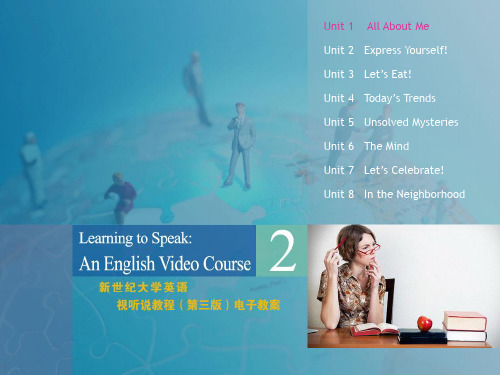
■
2 passport 1 diary 3 yearbook
Unit
1
All About Me
Lesson A The people in my life Lesson B Special people and memories
An English Video Course 2 视听说教程(第三版)电子教案 2
Listening Activity 1 Nosy Nora Language Notes Proper names Myles Katherine Jones Parkside Apartments New words van nosy n. a. 小货车 多管闲事的,爱打听的 move in 搬进来,迁入 Wes Nora Nelson Lydia Mrs. Hanson
Unit
1
All About Me
Lesson A The people in my life Lesson B Special people and memories
An English Video Course 2 视听说教程(第三版)电子教案 2
Listening Activity 1 Nosy Nora A Katherine is moving into an apartment. She is meeting Nora for the first time. Listen to the conversation. Check (√) the things you know about the people in each apartment.
Listening Activity 1 Nosy Nora B Listen again. What do you think nosy means? What might a nosy person do?
新视野大学英语第三版视听说教程第一册教案(Units1-5)
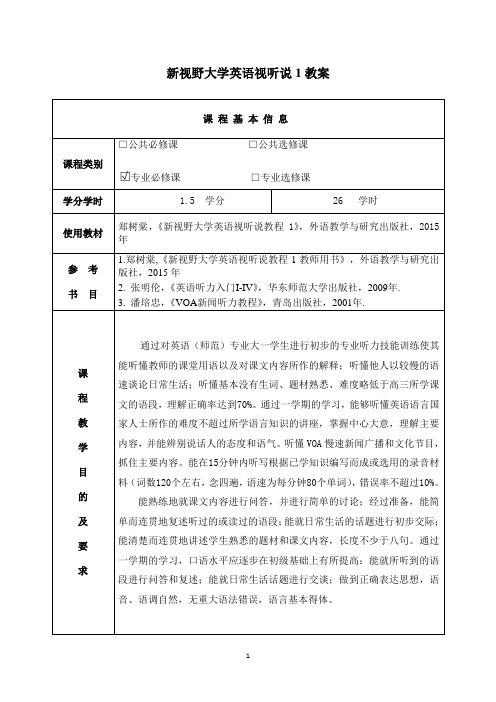
新视野大学英语视听说1教案
课程基本信息
课程类别
□公共必修课 □公共选修课
专业必修课 □专业选课
学分学时
1.5 学分
26 学时
使用教材
郑树棠,《新视野大学英语视听说教程1》,外语教学与研究出版社,2015年
参考
书目
1.郑树棠,《新视野大学英语视听说教程1教师用书》,外语教学与研究出版社,2015年
2.张明伦,《英语听力入门I-IV》,华东师范大学出版社,2009年.
Speaking skills:Keeping a conversation going
Keeping a conversation going is an important speaking skill for exchanging information with or showing politeness to other people. There are several ways to keep a conversation going.
3) keep a conversation going
4) conduct an interview
4. Vocabulary, and Expression:
social, clubbing, disco, cute, fish and chips, Johannesburg, orphanage, Cuban, FIFA…
新世纪大学英语视听说4unit7电子教案
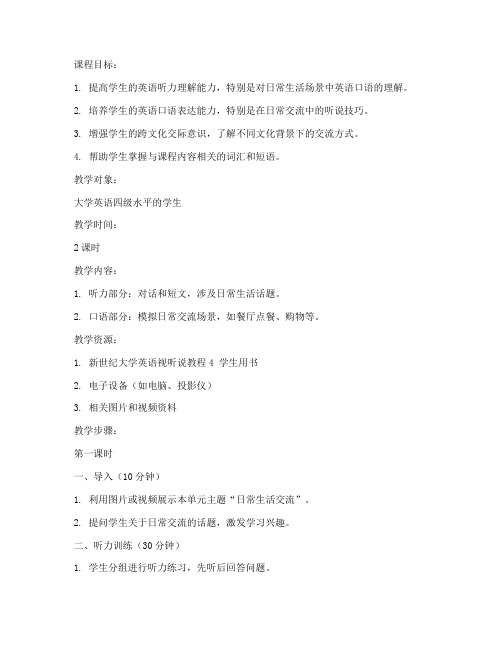
课程目标:1. 提高学生的英语听力理解能力,特别是对日常生活场景中英语口语的理解。
2. 培养学生的英语口语表达能力,特别是在日常交流中的听说技巧。
3. 增强学生的跨文化交际意识,了解不同文化背景下的交流方式。
4. 帮助学生掌握与课程内容相关的词汇和短语。
教学对象:大学英语四级水平的学生教学时间:2课时教学内容:1. 听力部分:对话和短文,涉及日常生活话题。
2. 口语部分:模拟日常交流场景,如餐厅点餐、购物等。
教学资源:1. 新世纪大学英语视听说教程4 学生用书2. 电子设备(如电脑、投影仪)3. 相关图片和视频资料教学步骤:第一课时一、导入(10分钟)1. 利用图片或视频展示本单元主题“日常生活交流”。
2. 提问学生关于日常交流的话题,激发学习兴趣。
二、听力训练(30分钟)1. 学生分组进行听力练习,先听后回答问题。
2. 教师播放听力材料,学生根据问题进行回答。
3. 教师总结听力要点,讲解词汇和短语。
三、口语练习(20分钟)1. 教师设置模拟场景,如餐厅点餐、购物等。
2. 学生分组进行角色扮演,练习口语表达。
3. 教师巡视指导,纠正发音和语法错误。
四、课堂小结(10分钟)1. 回顾本节课所学内容,强调重点词汇和短语。
2. 布置课后作业,如复述听力材料、模拟日常交流场景等。
第二课时一、复习(10分钟)1. 回顾上一节课所学内容,检查学生掌握情况。
2. 学生进行听力复述,教师点评。
二、口语练习(30分钟)1. 教师设置不同场景,如旅行、就医等,学生进行角色扮演。
2. 教师引导学生注意语调、语速和语音,提高口语表达能力。
三、小组讨论(20分钟)1. 学生分组讨论本单元话题,如“如何提高日常交流能力”。
2. 每组选派代表进行发言,分享讨论成果。
四、课堂小结(10分钟)1. 回顾本节课所学内容,强调口语表达技巧。
2. 布置课后作业,如查找与日常生活相关的英语材料,进行口语练习。
教学反思:本节课通过听力、口语和小组讨论等多种教学形式,帮助学生提高英语听说能力,增强跨文化交际意识。
大学英语视听说 Unit

II ■
□√ The Burj Al Arab Hotel
Dubai; United Arab
Emirates
□× The Peninsula Hong □× The Hotel Rita Paris;
Kong Kowloon; Hong
France
Kong; China
6 Unit
Wealth
Lesson A Having it all
1. spend August in a s_u_m__m_e_r_h_o_u_s_e_ by the sea 2. hire a _l_im__o_u_s_in_e__d_ri_v_e_r to drive me to work every day for a month 3. buy the latest _d_e_si_g_n_e_r_c_lo_t_h_e_s_at an expensive boutique 4. send your child to an expensive _p_r_i_v_at_e_s_c_h_o_o_l_ for an academic year 5. hire your own _p_e_r_so_n_a_l_t_r_a_in_e_r for six months and get in shape 6. stay in a l_u_x_u_r_y_s_u_i_te_ in a five-star hotel for a month 7. hire a _p_r_iv_a_t_e_j_e_t _ and fly around the world for a week 8. have all the money you owe on your _c_r_e_d_it_c_a_r_d_ paid off for you 9. invite your friends on a fifteen-minute shopping spree with unlimited _s_p_e_n_d_in_g__m_o_n_e_y_
新视野大学英语视听说教程第二册第一单元教案

授课题目:Unit 1 Life is a learning curve授课时间:第____周第____周授课类型:实训课授课时数:4教学目的及要求:By learning this unit, the student should1) be able to talk about learning experiences.2) listen for signal words for listing.3) give and respond to advice.4) talk about learning / teaching methods.教学重点及难点:1.Listening skill: listen for signal words for listing.2.Speaking skill: give and respond to advice.教学方法和手段:Task-based communicative, multi-modal teaching through:1.Recording listening;2.Video watching;3.PPT showing;4.Individual work, pair work & group work.教学内容和过程:Unit 2 A Break for FunStep One Opening upRead the following quotes about learning. Do you agree with them Why or why notWe learn by doing.— Aristotle.I partly agree with the quote because it is not the only way of learning: We gain first-hand experience by interacting with the environment;We gain second-hand experience by reading books.A little knowledge is a dangerous thing.— Albert EinsteinYes. It is dangerous for a person who knows a little about something thinks he knows it all.The best way to learn is to teach.— AnonymousYes. Going through the process of trying to explain something to others will help you understand, absorb and consolidate what you have learned.Step Two Listening to the worldI.Sharing1.Watch a podcast for its general idea.2.Watch Part 1 and fill in the blanks.3.Watch Part 2 and check the true statements.4.Watch Part 3 and fill in the blanks.5.Work in pairs and discuss the question.II.Listening1.Introduce the listening Skill: Listening for signal words for listing2. Listen for the total number of items at the beginning3. Listen for words and expressions that signal the beginning, followingand end of the listing4. . the last, the final, lastly, and finally5. Listing items with equal value6. . to begin with, to start with, furthermore, moreover, in addition,besides, what’s more, the las t but not the least, lastly, finally7.Words and expressions indicating importance8. expressions: above all, the most important / obvious / noteworthy9.Adjectives: main, vital, significant, chief, central, principal,primary, major, distinctive, and the –est forms of adjectives Listen to Part 2 of the radio program. Then match the people to the film stars they like.10.Listen to a radio program and rearrange the following expressions.11.Listen to the radio program again and complete the table.12.Fill in the blanks.13.III.Viewing1.Read the program information below and check the true statements.2.Read the statements. Then watch the video clip and underline thecorrect alternative.3.4.Read the statements and the answer choices. Then watch the video clipagain and choose the best answers.Step Three Speaking for communication1.Read the statements. Then listen to a conversation and check the truestatements.2.Read the table. Then listen to the conversation and write G for givingadvice and R for responding to advice in the right column.3.Speaking Skill: Giving and responding to adviceGiving and responding to advice in an appropriate way are useful and important speaking skills.Expressions for giving adviceWhy don’t you…My( main/personal) recommendation/suggestion/ is/would be…If that happened to me/ If I were in your place/ if I were you/ In that case, I’d recommend…Do you think it is a good idea…The sooner you…the better.…might work/ would probably work/is worth a try.If you ask me/ The way I see it, it probably would have been better(not) to have…Expressions for responding to advice•Thank you, I’ll take that into consideration.• Thanks. That sounds good/interesting.I hadn’t thought of that before. Thank you so much for offering that advice.Thank you fo r the advice. I’ll try…Maybe you’re right.Thanks for saying that.4.Look at the pictures and read the conversations below. Then fill inthe blanks using the words in brackets.5.Role-play the situations.Step Four Further practice in listeningI.Short Conversations1 Q: What can we learn from the conversationB The woman should seek help from the writing center.2 Q: Why does the woman choose to learn FrenchD She thinks speaking French is a must for cultured people.3 Q: What did the man do last nightD He attended a speech.4 Q: What made Melissa unhappyC That she lost her chance to enter the contest.5 Q: What does the man think of the woman’s opinionA It is one-sided.II. Long Conversation1 Q: How is the woman doing in the man’s cl assC She often fails to turn in her homework on time.2 Q: What does the woman think of learning SpanishD It presents difficulty for her.3 Q: What do we know from this conversation about the manA He has a good personal relationship with the woman.4 Q: What is the woman most likely to do after talking with the manC Work harder in her Spanish class.III. Passages1.Passage one1 Q: What do you know about the speaker’s Spanish learning experience in high schoolD She showed dissatisfaction with the slow pace of her class.2 Q: What made the speaker feel more frustrated while learning Spanish in high schoolA She had to learn the material that she already knew.3 Q: What did the speaker say about her study of Spanish literature in collegeC It proved to be an unbalanced way to learn the language.4 Q: Which experience benefited the speaker most in terms of her use of SpanishD She taught Spanish speakers how to speak English.2. Passage two1) alternative2) numerous3) traditional4) academic5) countryside6) athletes7) take advantage of8) Secondary9) in a collective effort10) serve as作业:Preview Section B参考文献:1.郑树棠. 新视野大学英语视听说教程(第三版)第二册[M]. 北京:外语教学与研究出版社,2015.2.郑树棠. 新视野大学英语视听说教程(第三版)第二册教师用书[M]. 北京:外语教学与研究出版社,2015.3.夏纪梅. 现代外语课堂设计理论与实践[M]. 上海:上海外语教育出版社,2003.4.秦秀白. 《新世纪大学英语系列教程》第二册[M]. 上海:上海外语教育出版社,2007(2009重印).5.杨治中主编.《新起点大学基础英语教程系列》第二册[M]. 北京:外语教学与研究出版社,2004.6.翟象俊等主编. 《21世纪大学英语系列教程》第二版第二册[M]. 厦门:复旦大学出版社,2008.课后小结:。
大学英语视听说2_教案
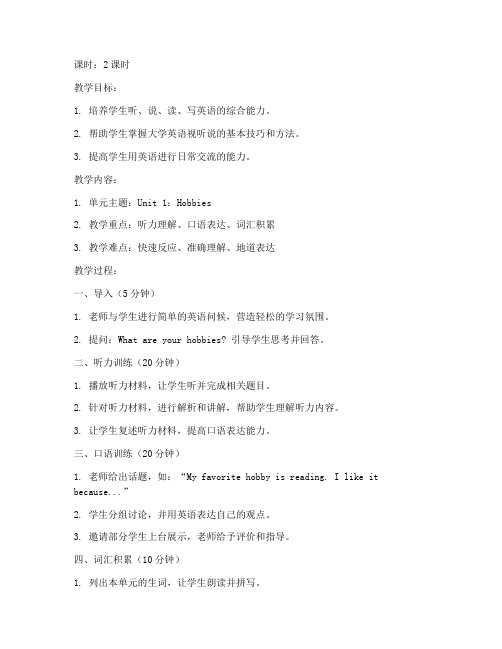
课时:2课时教学目标:1. 培养学生听、说、读、写英语的综合能力。
2. 帮助学生掌握大学英语视听说的基本技巧和方法。
3. 提高学生用英语进行日常交流的能力。
教学内容:1. 单元主题:Unit 1:Hobbies2. 教学重点:听力理解、口语表达、词汇积累3. 教学难点:快速反应、准确理解、地道表达教学过程:一、导入(5分钟)1. 老师与学生进行简单的英语问候,营造轻松的学习氛围。
2. 提问:What are your hobbies? 引导学生思考并回答。
二、听力训练(20分钟)1. 播放听力材料,让学生听并完成相关题目。
2. 针对听力材料,进行解析和讲解,帮助学生理解听力内容。
3. 让学生复述听力材料,提高口语表达能力。
三、口语训练(20分钟)1. 老师给出话题,如:“My favorite hobby is reading. I like it because...”2. 学生分组讨论,并用英语表达自己的观点。
3. 邀请部分学生上台展示,老师给予评价和指导。
四、词汇积累(10分钟)1. 列出本单元的生词,让学生朗读并拼写。
2. 解释生词的用法和例句,帮助学生记忆。
五、小结(5分钟)1. 回顾本节课的学习内容,强调重点和难点。
2. 鼓励学生在课后进行自主学习和练习。
教学评价:1. 学生对听力材料的理解程度。
2. 学生口语表达的能力。
3. 学生对词汇的掌握情况。
课后作业:1. 复习本节课的听力材料,完成相关练习。
2. 搜集有关自己爱好的英语文章,进行阅读和翻译。
3. 准备一个关于自己爱好的英语演讲,下节课进行展示。
教学反思:1. 本节课通过听力、口语、词汇等环节,提高了学生的英语综合能力。
2. 在教学过程中,注重培养学生的自主学习能力和团队合作精神。
3. 针对学生的个体差异,给予个性化的指导和帮助。
大学英语视听说教案.doc
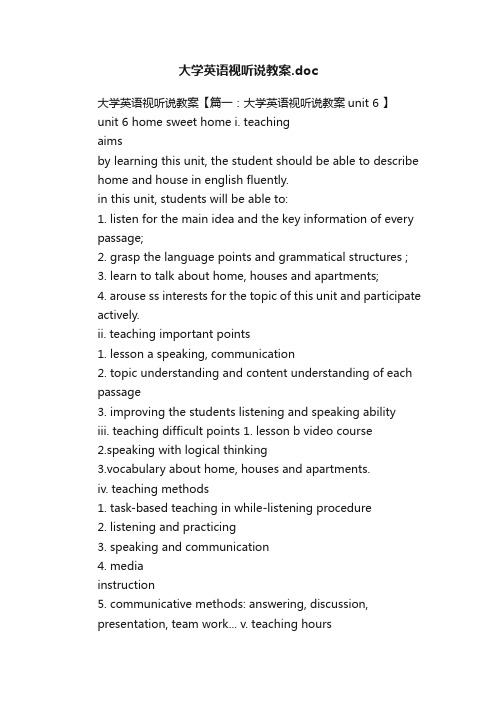
大学英语视听说教案.doc大学英语视听说教案【篇一:大学英语视听说教案unit 6 】unit 6 home sweet home i. teachingaimsby learning this unit, the student should be able to describe home and house in english fluently.in this unit, students will be able to:1. listen for the main idea and the key information of every passage;2. grasp the language points and grammatical structures ;3. learn to talk about home, houses and apartments;4. arouse ss interests for the topic of this unit and participate actively.ii. teaching important points1. lesson a speaking, communication2. topic understanding and content understanding of each passage3. improving the students listening and speaking ability iii. teaching difficult points 1. lesson b video course2.speaking with logical thinking3.vocabulary about home, houses and apartments.iv. teaching methods1. task-based teaching in while-listening procedure2. listening and practicing3. speaking and communication4. mediainstruction5. communicative methods: answering, discussion, presentation, team work... v. teaching hours10 class periodsvi. teaching procedures 1. lead-in /warming uptry to describe your sweet home like the examples.2. lesson a : vocabulary link1. direct ss ’attention to the pictures. present the vocabulary.have them read the sentences and number the pictures. matcheach word with a place in the apartment. check answers.demonstration to the class.3. lesson a : listening(1). apartment huntingfamiliarize ss with the new words. have them read the new words aloud after you. explain the task. play the recording.check answers.tell ss to listen again and mark their answers. play therecording. check answers. introduce the topic that the man talks about three apartments. number the apartments 1 to 3 asyou listen. have ss listen and fill in the blanks with words they hear. play the recording. check answers. have ss read through the questions and possible answers. tell ss to listen again and check the correct boxes. play the recording. check answers.(2). a housing problemintroduce the topic :listen to graciela talk to an adviser at her school. then answer the questions. then tell them to listen andnumber the steps in order. play the recording. check answers.tell ss to listen again and answer the questions. play therecording. check answers.(3). the davis family wants a new home.tell ss they are going to listen to the program “places for rent. ”. direct ss ’attention to the picture anadsk them to read the questions. tell ss to listen and answer the questions. play the recording. check answers.tell ss to listen again and fill in the blanks with the words in thebox. play the recording. check answers.(4). make yourself at home!introduce the topic. tell ss they are going to listen to apassage. tell ss to listen carefully and write short answers to the questions. play the recording.check answers.have ss look at the pictures carefully. tell them to listen to the recording andnumber the pictures to match them with the explanations. playthe recording. check answers.tell ss to listen again and fill in the blanks with the words they hear. play the recording. check answers.(5). object-shaped housesdirect ss ’attention to the title. w hat will they hear? present thenew words and have ss read aloud after you. answer anyquestions about vocabulary.with the class, go over the list of questions. tell ss to listen and number the questions in the order they are asked during the interview. play the recording. check answers.have ss read the statements. explain that all these statements are false. tell ss to listen again and correct the statements. playthe recording. check answers.tell ss to listen again and write answers to the questions. play the recording. checkanswers.4. lesson a : pronunciation1. remind students rising intonation to show surprise. play therecording. have ss work in pairs to practice the conversations.2. have ss listen and read the sentences. play the recording.ask ss to work inpairs to read the sentences. check their pronunciation..5. lesson a : speaking and communicationactivity one1. introduce the situation. how many rooms are there? ask ssto listen and fill in the blanks with the words they hear. play therecording.check answers.2. put ss in groups of three. present the conversations again.ask ss to listen and read along in their groups. play therecording again. ask ss to practice the conversations ingroups. remind ss to keep eye contact with their groupmembers while speaking.3. ask ss to work in groups of three. ask ss to read the modelconversation. answer any questions about vocabulary. ifnecessary, play the recording. elicit or explain to ss who the famous celebrities are.4. have ss work in groups of three. each student should role-play a famous person. have ss work in their groups to create and practice a new conversation where they introduce each other. when all groups【篇二:大学英语视听说3-unit1 教案及首页】北华航天工业学院教案unit 1 interests and hobbiesi. dictationask the students to do the dictation of the words in text a unit1.ii. lead-in and video-watchingask the students to work in groups, learn to express likes or dislikes i (don ’t) like ??is my favorite. i prefer ?to ?i care for ?is the last thing i would do watch the video and do the exercisesiii. listening skills for short passages1. a few ways to help students conclude the main idea 1).explaining what a topic sentence isusually placed in the beginning, or at the end of a passage, orsome times appears in the middle of the passage where the key words are frequently repeated. 2). listening for general idearead and analyze the choices first. infer the question. find the repeated words. listen to the passage and pay special attentionto the beginning or the ending part of the passage.2. skill practice: listen to the following three passages andanswer the questionsiv. comprehensive training put the skills into practice1. 5 short conversations and a long conversation2. 1 shortpassage 3. dictationv. assignment1. further listening practice in unit 12. remember the new words, phrases in the listening exercises3. finish the exercises left in unit 1 in students ’textbooks北华航天工业学院教案unit 2. life and fashioni. dictationask the students to do the dictation of the words in text a unit2.ii. lead-in and video-watchingask the students to work in groups, learn to seek advice from others how do you feel? what about...?how do you think about ?whats your opinion? what is your view? what do you think? watch the video and do the exercises iii. listening skillsfor short passages1. make the students familiar with different kinds of numbers2.explain how the numbers are tested.3. tips: pay attention to the digit; pay attention to the ways ofreading numbers; pay attention to the use of commas; pay attention to the calculation.4. skill practice: listen to the following three passages andanswer the questionsiv. comprehensive training put the skills into practice1. 5 short conversations and a long conversation2. 1 shortpassage 3. dictationv. assignment1. further listening practice in unit 22. remember the new words, phrases in the listening exercises3. finish the exercises left in unit 2 in students ’textbooks北华航天工业学院教案【篇三:《新视野大学英语视听说教程3》课时10 教案】《新视野大学英语视听说教程3》课时10 教案(u nit 1 part Ⅱ~unit 1 part Ⅳmodel 1 )授课人:成诚文章大意:墨菲和一个美国人去应聘同一个职位,由于他们学历相同, 所以主管对他们进行了一次测试,结果他们都有一个问题没有回答出来,但最终美国人却被录取,这是为什么呢?(原因:美国人在不会的题目上写的是”我不会”而墨菲写的是”我也是”.★word tips:1.dublin: 都柏林(爱尔兰首都)①(令人吃惊的)巧合,巧事2.coincidence:[ k?uinsid?ns][n] ②同时存在③(意见等的)相同,相符,一致3.bewilder:[ biwild?][v] 使迷惑,使糊涂4.indignant:[ indign?nt][adj] ~(at/about something) 愤慨的,愤怒的,义愤的★words in text:irish[ai?ri?][n] ①爱尔兰语②爱尔兰人[adj] 爱尔兰的,爱尔兰人的,爱尔兰语的文章大意:本文讲述了在应聘时常被问到的一些难题,作者通过本文教你如何去应对这些问题.★word tip:customize:[ k?st?maiz][v]( 以满足顾客的需要)订制,订做,改制★words in text:1.relevant:[ reliv?nt][adj] ①紧密相关的,切题的②有价值的,有意义的①(用于有害事物)面临,遭受(危险或不快)②(用于揭露事实)揭露2.exposure:[iksp?u??][n] ③(用于电视,报章等)(在电视,报纸等上)亮相,被报道④(用于身体状况)挨冻,受寒⑤(用于照相机胶片)⑴(拍依仗照片的)软片,底片,胶片⑵暴光时间时间⑥暴露,显露文章大意:susan 要找工作,但都没有合适的,于是找john 帮忙出主意,那么最终susan选到合适的工作了吗?★word tips:1.job fair:劳务市场2.sue: [sju:] ①要求、请求;控告②控告、起诉3.ad=advertisement: 广告4.update:[v] ①使现代化,更新②向??提供最新信息,给??增加最新信息5.it=information technology: 信息技术文章大意:susan 即将去面试,向john请教如何才能更好的通过面试.★word tip:fringe[frind?] benefit:[n]( 工资外的)额外补贴,附加福利★words in text:aggressive:[ ?gresiv](line 5)[adj] ①好斗的,挑衅的,侵略的,富于攻击性的②进取的文章大意:helen 所在的公司准备从头开始,招收新人。
新标准大学视听说unit1教案

课程名称:《新标准大学英语视听说》教学目标:1. 通过本节课的学习,学生能够理解并掌握听力材料中的关键信息。
2. 学生能够运用所学词汇和句型进行日常对话。
3. 培养学生的听力理解能力和口语表达能力。
4. 增强学生对英语国家文化背景知识的了解。
教学内容:1. 听力材料:关于大学校园生活的对话。
2. 词汇:campus, dormitory, library, class, professor, assignment, etc.3. 句型:How do you like your campus life? What do you usually do in your free time? etc.教学步骤:一、导入1. 教师简要介绍本节课的主题:大学校园生活。
2. 学生自由讨论自己学校的校园生活,激发学生的兴趣。
二、听力训练1. 教师播放听力材料,学生认真听并做笔记。
2. 教师提问,检查学生对听力材料的理解情况。
3. 学生复述听力材料,教师点评。
三、词汇学习1. 教师带领学生复习并学习新词汇:campus, dormitory, library, class, professor, assignment, etc.2. 学生运用新词汇进行造句,教师点评。
四、口语练习1. 教师给出以下情景,让学生进行角色扮演:- A:How do you like your campus life?- B:I like it very much. I usually go to the library to study after class.- A:What do you usually do in your free time?- B:I like to play sports with my friends and watch movies.2. 学生分组进行练习,教师巡视指导。
五、总结1. 教师对本节课所学内容进行总结,强调重点词汇和句型。
- 1、下载文档前请自行甄别文档内容的完整性,平台不提供额外的编辑、内容补充、找答案等附加服务。
- 2、"仅部分预览"的文档,不可在线预览部分如存在完整性等问题,可反馈申请退款(可完整预览的文档不适用该条件!)。
- 3、如文档侵犯您的权益,请联系客服反馈,我们会尽快为您处理(人工客服工作时间:9:00-18:30)。
Unit 4 ChangeI. Teaching AimsIn this unit, students will be able to:1. Listen for the main idea and the key information of every passage;2. Arouse Ss’ interests for the topic of this unit and participate actively;3. Grasp the language points and grammatical structures ;4. Learn to talk about “I need a change”.II. Teaching important points1. Lesson A Speaking, Communication2. Topic understanding and content understanding of each passage3. Improving the students' listening and speaking abilityIII. Teaching difficult points1. Lesson B Video Course2. Speaking with logical thinking3.Vocabulary about the topicIV. Teaching Methods1. Task-based teaching in while-listening procedure2. Listening and practicing3. Speaking and communication4. Media instruction5. Communicative Methods: answering, discussion, presentation, team work... V. Teaching hours10 class periodsVI. Teaching Procedures1. Lead-in / Warming upWhat’s your dream?Have you ever thought about doing something for these children to help them realize their dreams?Could you say something about Kofi Annan Ghana , the seventh Secretary-General of the United Nations?2.Lesson A : Vocabulary Link1. Direct Ss’ attention to the pictures. Present the vocabulary. Have them read the sentences and number the pictures. Check answers.2. Have Ss work in pairs. If there is one student left, ask him or her to join a pair to make a group. Tell Ss they will interview one another, asking and answering the questions: What changes do you want to do...? Present the listed situations and people. Answer any questions about vocabulary. Ask Ss to fill in the blanks before practicing the model conversation. Have Ss create more conversations. Invite one or two pairs to give a demonstration to the class.3. Lesson A : Listening1. Familiarize students with the new words in activity one. Have them read the new words aloud. Present the situation. Tell Ss they are going to hear sth about “New Year’s resolutions”. Have Ss read the statements in the box. Ask Ss to listen and check the confirmed statements. Play the recording . Check answers.2. Present the situation. Tell Ss they will hear a conversation between Mike and Paula. Ask Ss to listen and number the objects in the order they hear them. Play the recording . Check answers.Tell Ss to listen again and complete the sentences. They must either circle the correct answers or fill in the blanks. Play the recording. Check answers.3. Present the situation. Tell Ss they will hear a interview about Yeliz’s story. Have them read the questions so they know what information to listen for. Ask Ss to listen and write short answers to the questions. Play the recording. Check answers.Have SS read the short summary. Tell them to listen to the talk again and fill in the blanks with the words they hear. Play the recording. Check answers.4. Introduce the situation. Explain that Ss will listen to a talk about finding your dream. Tell Ss to read the steps as listed in the table. Have them listen to the talk carefully and write their answer. Play the recording. Check answers.Have Ss listen to the talk again. Play the recording. Check answers.5. Present the situation. Tell Ss they will hear a talk about their dreams. Ask Ss to read the questions so they know what to listen for. Have them listen carefully and write short answers to the questions. Play the recording. Students write down their answers, then the teacher checks the answers.Have Ss listen to the passage again and complete the sentences by filling in the blanks. Play the recording. Check answers. The talk again and fill in the blanks with the words they hear. Play the recording. Check answers.4. Lesson A : Pronunciation1. Remind students when they should reduce want to. Play the recording. Have Ss work in pairs to practice the conversations.2. Have Ss listen and read the sentences. Play the recording. Ask Ss to work in pairs to read the sentences. Check their pronunciation..5. Lesson A : Speaking and communicationActivity One1. Introduce the situation .Explain that When making requests, could is a little more polite than can. If your response to a request is negative, you usually give areason. Ask Ss to listen and fill in the blanks with the words they hear.Play the recording. Check answers. Elicit or explain that Conversation 1 is informal and Conversation 2 is formal.2. Put Ss in groups of three. Present the conversations again. Ask Ss to listen and read along in their groups. Play the recording again.Ask Ss to practice the conversations in groups. Remind Ss to keep eye contact with their group members while speaking.3. Ask Ss to work in groups of three. Ask Ss to read the model conversation. Answer any questions about vocabulary. If necessary, play the recording. Elicit or explain to Ss who the famous celebrities are.4. Have Ss work in groups of three. Each student should role-play a famous person. Have Ss work in their groups to create and practice a new conversation where they introduce each other. When all groupsActivity Two1. Have Ss work individually to write three sentences about themselves, and another three sentences about themselves.2. Collect and redistribute the papers.3. Model the activity for Ss.Have Ss stand up with their papers and walk around asking and answering questions.6. Lesson B: Video Course Plans and DreamsGlobal Viewpoints Making change1. Say the list of vocabulary items aloud as Ss repeat for pronunciation practice. If necessary, explain the meaning of the words. Have Ss complete the sentences using the correct words from the New words. Check answers.2. Explain to Ss that they are going to watch several people talking about plans and dreams. Before viewing, have Ss read the statements so they know what towatch and listen for. Ask Ss to watch and circle True if the statement is completely correct. If it is False, they must listen for information to correct for it. Play the video. Check answers.3. Tell Ss they will watch the interviews. Ask Ss to fill in the missing words as they watch the video. Play the video. Check answers.Goals, plans and dreams1.Read the underlined words aloud for pronunciation practice. Ask Ss to complete the sentences using the underlined words. Check answers.Present the situation. Tell Ss they will watch people talking about goals, plans and dreams. Ask Ss to read the text so they know what to watch and listen for. Explain to Ss that they are to fill in the missing words as they watch the video. Play the video. Check answers.7. Lesson B:City Living Mike needs a change1. Have students look at the pictures and read the story line aloud. Check Sscomprehension. You may have Ss predict what they think happens in the video.2. Have Ss use the information from the pictures and captions to complete the sentences. Checks answers.8. Lesson B:City Living Mike needs a change “While You Watch”1. Before viewing, have Ss read the sentences so they know what to watch and listen for. Ask Ss to watch and then match the sentence parts to make true sentences. Play the video. Check answers.2. Give Ss time to study the pictures and sentences. Tell Ss: While you watch, write the number of the picture next to the correct sentence. When the video is finished, you will have time to label the pictures. Play the video and allow time for Ss to answer. Check answers.3. Give Ss time to study the pictures and questions. Ask Ss to pay attention to what people say in the video. Play the first episode of the video. Check answers.4. Give Ss time to study the pictures and questions. Ask Ss to pay attention to what people say in the video. Play the second episode of the video and allow time for Ss to fill in the blanks. Check answers.Class work: Show the script of the second episode of the video on the screen. Explain that some of the words are missing. Play the 2nd episode and ask Ss to act out the lines of the script as a class. Check answers.5. Give Ss time to study the pictures and script. Play the third episode of the video and allow time for Ss to fill in the blanks. Check answers.6. Give Ss time to study the question. Play the whole video once again andallow time for Ss to answer. Check answers.9. Lesson B:City Living Mike needs a change “After You Watch”1. Read the useful expressions dialogues aloud, emphasizing the expressions in blue. Encourage students to think of how the phrases were used in the video before matching the expressions to the definitions. The teacher checks the answers.2. Read the examples given from the video. Have Ss fill in the blanks with the correct forms of the verbs in brackets. Check answers.3. Ask Ss to write a short summery of the City Living story.VII. Assignments1. Oral practice: I need a change (pair work or group work)2. Write a short summary of the City Living story3. Dictation4. Preview & preparation: Unit Five。
